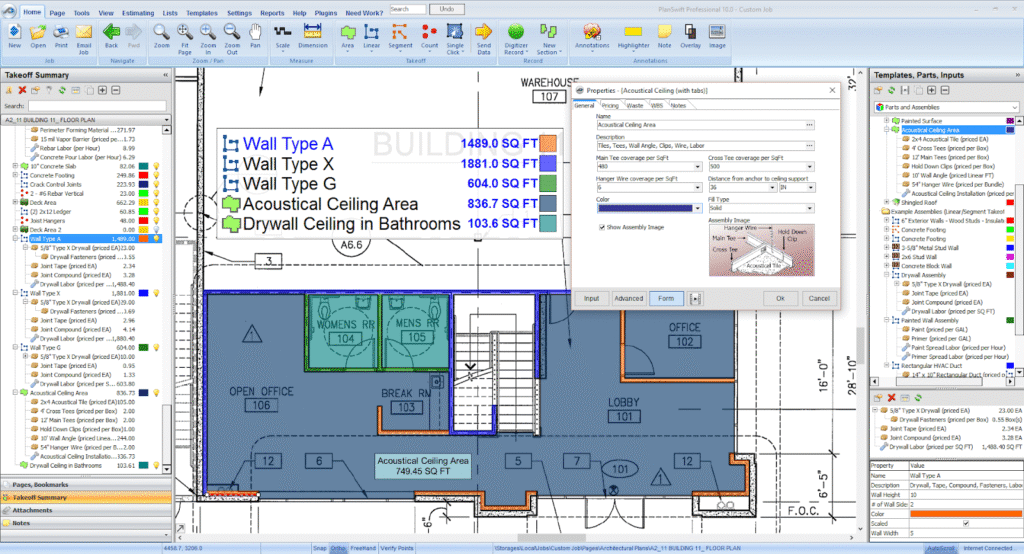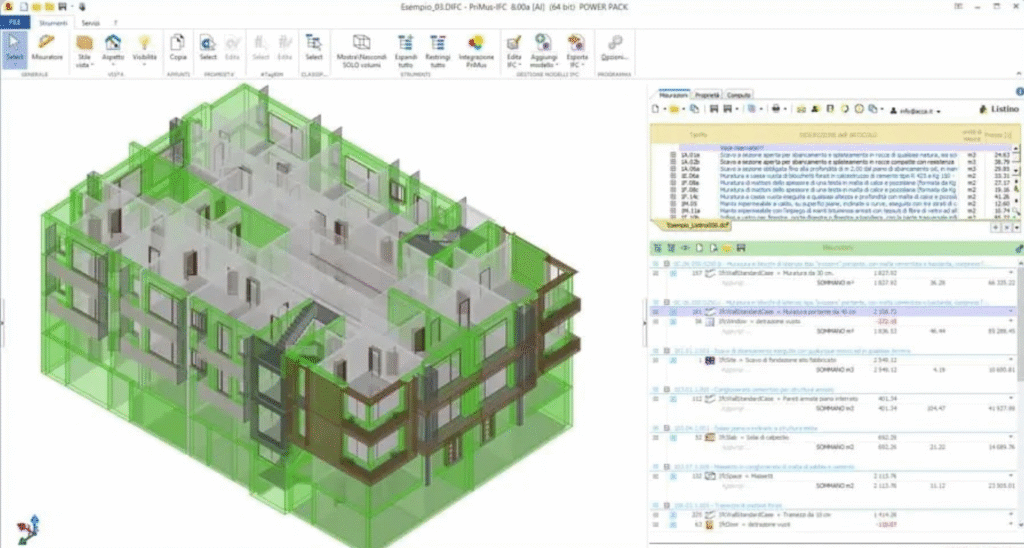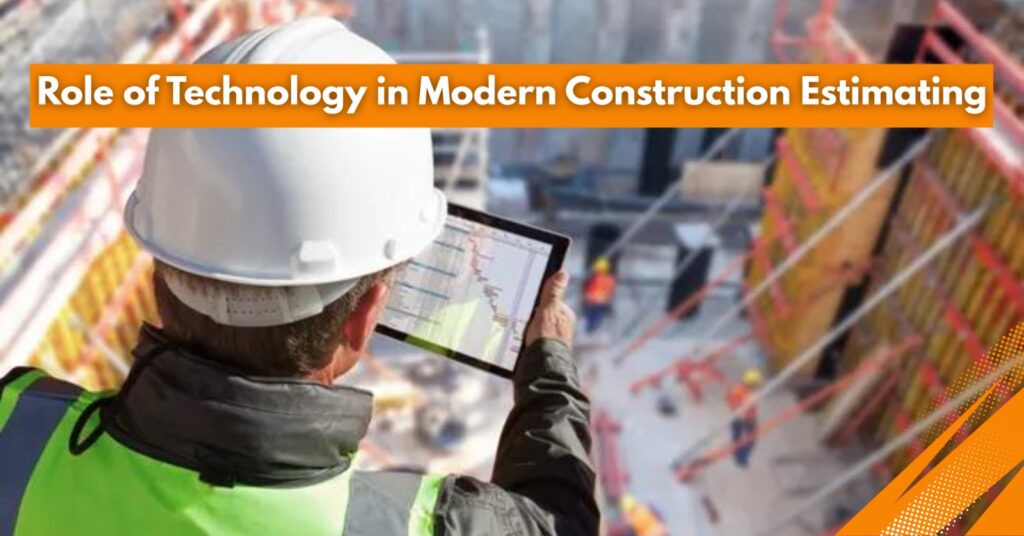Contractors staring at a stack of blueprints and doing hours of hand-measuring lead to mistakes. Material costs creep up unexpectedly. Deadlines slip because your bid was off. Sound familiar? These headaches hit hard in construction estimating. But tools such as software automation, AI, and Building Information Modelling (BIM) are changing the game. They help deliver precise estimates faster so you can focus on building instead of worrying about numbers. Technology is fixing all that. Tools like software automation, AI and Building Information Modelling (BIM) make estimates spot-on, fast and profitable. You win more projects without the stress. Let’s break it down step by step so you can see how to make this work for your next project.

Overview of Technology in the Construction Industry
Technology has integrated itself into every part of construction, from planning to completion. In this era of technology, digital tools handle tasks that once relied on paper and pencils. For instance, project management apps streamline scheduling while drones inspect sites for quick insights. Estimating this shift means moving from guesswork to data-driven decisions.
Cloud computing is helping teams to access real-time data anywhere. This reduces miscommunication and keeps everyone updated. Studies showed that firms using digital technologies have up to 50% faster inspections and fewer errors on-site. Emerging tech like AI analyses past projects to predict future costs. Overall, these advancements boost efficiency and productivity across the board.
One common issue contractors deal with is waiting for client approvals, which stalls progress. Tech solves this by providing clear visual reports that speed up decisions. Another headache is poor project tracking, leading to overlooked details. Digital platforms offer dashboards that highlight issues early so you can fix them before they grow.
The Role of Digital Takeoff Software and Estimating Tools
Construction used to mean paper plans, pencils and endless math. Now tech handles the heavy lifting. From small home builds to big commercial sites, digital tools omit mistakes and save time.
Getting digitalised and automated calculations
Digital takeoff software turns blueprints into actionable data with just a few clicks. Instead of measuring plans by hand, you upload files and let the tool calculate quantities. This speeds up the process and minimises mistakes. For example, tools like PlanSwift or Bluebeam allow you to measure areas, lengths and volumes directly on screen. They export results to spreadsheets for easy integration with estimates. Contractors using these reports complete takeoffs in hours, not days.
Take affordable roofing estimates for contractors. Manual methods might miss hidden costs like material waste. Digital tools factor in everything from shingle counts to labour hours based on real specs. This leads to bids that are competitive yet profitable. You can search the best digital takeoff for residential builders and you’ll find tools that fit your scale.
Real Time Data
Estimating tools go beyond takeoffs. They include databases of current material prices updated in real time. This helps avoid underbidding due to outdated costs. Plus features like scenario analysis let you test different options quickly. If material prices rise, you can adjust estimates on the fly without starting over.
Project Tracking
Take project tracking. Old ways meant chasing phone calls for updates. Today apps show progress live on your phone. Teams spot delays early and fix them fast. Data backs this up. A report from McKinsey found companies using digital tech finish projects 20% faster. They also cut costs by 15%. That’s real money in your pocket.
Smooth Cash Flow
Contractors often struggle with cash flow. Bills pile up before payments arrive. Tech solves this with instant invoicing tied to milestones. No more waiting weeks for checks. It also cut the labor costs. One person does what two used to.
Regulatory Updates
A big challenge is keeping up with changing rules like safety codes or green building standards. Software updates automatically. So your estimates stay compliant. Take affordable roofing estimates for contractors. Weather delays and supply shortages eat profits. Tech pulls live data on shingle prices and labour rates. Your bid stays competitive without losing money.
How BIM and AI are Enhancing Estimating Accuracy
BIM builds a digital twin of your project. Every pipe door and beam shows up in 3D. BIM creates 3D models that include every detail of a project. This virtual build lets estimators pull exact quantities from the model, reducing guesswork.
BIM integrates with cost data for what’s called 5D modelling, where time and money link to the design. You can see how changes affect the budget instantly. For instance, adding a window updates material needs and labour costs automatically.
AI takes this further by learning from historical data. It spots patterns in past projects to forecast risks and costs more precisely. AI can trim process time and cut errors by up to 90% compared to manual ways. For example it might flag potential overruns in labor based on similar jobs.
Together BIM and AI tackle pain points like cost overruns from design changes. Traditional methods often miss these until too late. With these techs you simulate scenarios and choose the best path early. A client shared his views that a residential builder using AI-powered estimating on a complex home renovation avoided a 15% budget overrun by predicting supply chain delays. “The accuracy gave us confidence to bid competitively and win more projects.”

Benefits of Adopting Technology for Construction Estimating
The following benefits address core challenges like underestimating labor or inadequate change order management. Adopting tech turns these headaches into strengths.
Accuracy
Switching to tech brings clear gains. First accuracy improves cutting human errors that plague manual estimates. Automated calculations ensure numbers add up right every time.
Speed
It is another big win. Tasks that took days now finish in hours, freeing up time for other work. This means you can handle more bids and grow your business.
Collaborations are easier
Collaboration gets easier too. Cloud-based tools let teams share updates in real time no matter where they are. This reduces miscommunication and keeps projects on track.
Cost savings
Better estimates mean fewer overruns and more profitable jobs. Firms report up to 50% reduction in inspection times with tech like AI drones.
On the flip side, ignoring tech leaves you behind. Competitors using these tools bid faster and win more. Pain points like inconsistent invoicing or cash flow issues worsen without digital tracking.
Improved Decision-Making and Reduced Mistakes
Real-time data helps choose the right materials and methods. AI predicts issues before they happen.
Scalability and Sustainability
Handle larger projects without adding staff. Optimise resources to cut waste.

How ALM Estimating Integrates These Technologies for Better Results
ALM Estimating brings together digital takeoff BIM and AI into one seamless service. This integration delivers estimates that are spot-on and quick, helping you secure projects with confidence. For instance, on a roofing job, ALM provided affordable estimates that accounted for all variables from weather impacts to material fluctuations. Clients see real results like reduced errors and faster turnaround. ALM Estimating has more than 20 years of experience and they have professionals specialised in networking the advanced tools, AI and BIM and latest technologies. They provide you with your desired construction estimates. Partner with ALM Estimating to achieve your desired competitive bids and projects.
Wrapping It Up: Embrace Tech for a Brighter Future in Construction
As we have seen, technology is not just a buzzword in construction estimating. It’s the key to unlocking smoother projects, bigger wins and less frustration. From digital takeoff tools to BIM and AI that spot hidden costs let contractors like to ditch old headaches like budget overruns and endless revisions. Imagine bidding with confidence knowing your numbers are rock solid and your team has more time to focus on what they do best, building. By adopting these innovations, you will not only stay competitive but also turn potential pitfalls into profits. The future is here, and it’s making estimating smarter, faster and more reliable than ever.
Ready to transform your roofing estimating? Contact ALM Estimating and get a 30% discount on your first order. See the difference today!
FAQs:
Q1. How does digital takeoff software actually save time when preparing roofing bids for contractors?
A. Digital takeoff software automatically measures blueprints and PDFs, pulling exact quantities for shingles, underlayment and flashing in minutes instead of days. For affordable roofing estimates for contractors, this means you complete takeoffs 80% faster, submit bids before competitors and win more jobs without hiring extra help.
Q2. What makes BIM such a game-changer for accurate cost estimating on construction projects?
A. BIM creates a detailed 3D model of your entire project, letting estimators extract precise material counts and detect design conflicts like pipes clashing with beams before construction starts. This saves 10-20% on costly rework and gives you bids that are 95% accurate compared to traditional 2D plans.
Q3. Can small contractors really afford to use AI-powered estimating tools without breaking the bank?
A. Absolutely, cloud-based AI estimating tools start at just $50 per month with no upfront costs and they pay for themselves quickly. For precise concrete estimating for small contractors, one accurate bid can save $2,000-5,000 in material waste making the investment recover in your very first project.
Q4. How reliable are AI predictions when forecasting material costs for upcoming construction jobs?
A. AI analyses real-time market data, supplier trends and historical pricing to deliver 90% accurate material cost predictions. Unlike manual estimates that often miss sudden 15-20% price spikes, AI keeps your bids profitable even when lumber or steel prices jump unexpectedly.
Q5. Does modern estimating software work reliably when I’m out on job sites without internet access?
A. Yes, most leading estimating software works completely offline so you can measure plans and build bids right from your truck or remote site. When you reconnect, it automatically syncs everything to the cloud ensuring you never lose important data during fieldwork.
Q6. What’s the easiest way to switch my team from manual estimating to digital tools without major training disruptions?
A.User-friendly tools like Stack or Bluebeam offer free 1-hour video tutorials, pre-built templates and drag-and-drop interfaces so your team can start producing accurate estimates the same day. Most contractors report their estimators are fully productive within 24 hours of switching.
Q7. Can BIM technology handle complex custom home designs for residential builders who do unique projects?
A. Definitely, BIM excels at modelling custom features like vaulted ceilings, spiral staircases or irregular rooflines, automatically calculating exact lumber, concrete and roofing needs. Residential builders using BIM report 25% faster bids and 15% higher win rates on custom homes.
Q8. How much do error rates actually improve when switching from traditional manual estimating to technology?
A. Manual estimating averages 12% error rates leading to thousands in overruns per project while technology drops errors to under 1%. This dramatic improvement means a $500,000 job that used to have $60,000 in potential errors now runs with just $5,000 risk.
Q9. How quickly can I generate a complete construction estimate using cloud-based estimating software?
A. With cloud estimating software you upload plans, do digital takeoff, add current pricing and generate a professional bid in just 2-4 hours compared to 3 full days using manual methods. This speed lets you respond to RFPs instantly and beat tight bidding deadlines every time.
Q10. Will these estimating technology tools integrate smoothly with my existing QuickBooks accounting software?
A. Yes, over 90% of modern estimating software offers one-click export directly to QuickBooks automatically transferring material costs, labor hours and totals. This eliminates double-entry errors and streamlines your workflow from bid submission straight through to client invoicing and payments.
